
A periodic round up of some of the rare and interesting vintage guitars for sale on the web just now: guitars, hard to find parts, catalogs and guitar memorabilia . Anything interesting that catches our eye - maybe a typically expensive guitar going for a great price - something that very rarely comes up, or even just an item with a great story. Got a suggestion for this page? let us know - you can promote your own stuff; if you tell us why it's interesting, it's more likely to be included.
Disclaimer: unless explicitly stated, vintageguitarandbass is not the vendor of any item shown on this page, nor will it be held liable for any unsatisfactory transaction. Please do your own research, look at feedback ratings (where applicable) and deal only with trusted sellers.
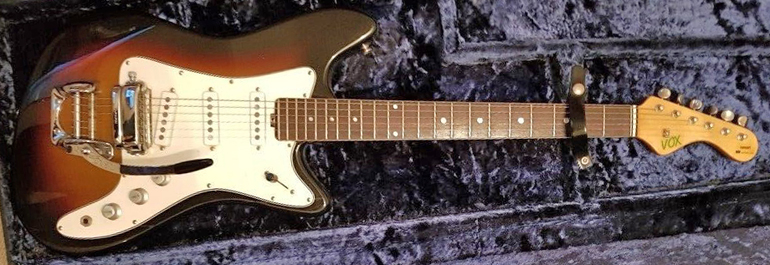
This is a very interesting guitar. The majority of Vox guitar models were designed in the UK in the early 1960s. With the massive explosion in guitar popularity (in general), and in Vox's popularity (specifically) in the mid sixties, Vox were forced to expand production beyond it's own capacity in the UK, primarily to deal with huge demand from the US. By 1965, solid body guitars destined for the UK market were built in the UK (with JMI and Vox branding), whilst those destined for America were built by Eko in Italy, and were simply branded as Vox. However, a very small number of early Italian Vox's did make it to the UK, and were given the decals (and model designations) of UK-built guitars. A few examples have come up over the years, most likely samples from the Eko plant before production started en-masse. This guitar, although designated as a Consort is effectively an Italian built Vox Spitfire (NOT to be confused with the semi-acoustic UK-built Vox Spitfire!). Although the UK Consort and Italian Spitfire look similar, the telling differences are as follows: 1) Italian necks have the visible truss rod nut at the base of the neck. 2) UK Consorts were fitted with a Hank Marvin tremolo with his signature engraved into the metal. 3) UK Consorts typically had un-labelled control knobs. 4) UK Consorts had no mute built into the bridge.
Finally, these Italian English guitars had an entirely different serial number system to either JMI built guitars (5 digit number, typically stamped into the headstock reverse, or latterly in the neck plate) or Italian guitars (6 digit number, usually stamped onto the neck plate). The few examples to come have all had numbers on small stickers, in the format 2x.xxx - i.e. five digits, but with a dot between digits two and three. Interestingly, this guitar looks like it might have a typical UK serial number stamped into the reverse of the headstock aswell.
This guitar is in exceptional condition for it's age, and comes with it's original case and strap. It is priced significantly above a typical JMI Consort, however, as explained it can be considered a special case. This guitar is in Cheshire, UK, and can be seen on gumtree
Although not mint, this Fender Mustang appears to be in exceptionally clean condition. Vintage guitars rarely remain in such a nice state, and when they do, they typically attract high sales prices, often very high. So it is somewhat surprising to see this beauty listed with a start price below $20 and no reserve. This will obviously attract a lot of interest, and will certainly sell; how high the bids will go remains to be seen. It's unlikely to exceed the typical 'buy-it-now' prices of most vintage Mustangs on ebay just now... watch this guitar!
Have a good look at the condition of this cool Mustang on ebay.com
Another STUPIDLY rare part on ebay. The Guild X702 is pretty rare on it's own, but I have seen examples with damaged scratchplates, especially around the output jack. This unused guard (still with protective plastic covering) is being sold give-away cheap. If you need this, get on it before someone else does! It could be decades before another comes up.
See this part on ebay.com
This listing is for some hard-to-find Gibson amp control knobs from the early 1960s. These really are not at all easy to find parts! As used on the Gibson Crestline amp range: Skylark GA-5, Discoverer GA-8, Explorer GA-18T, Falcon GA-19, Invader GA-30RVT, Les Paul GA-40T, Hercules GA-60, Vanguard GA-77RVTL, GA-79RVT Stereo amp, GA-100 bass amp, Rhythm King GA-200, Super 300 GA-300RVT, Super 400 GA-400 and Starfire TR-1000T, plus on some examples of the Atlas etc. And they seem in great condition. These will not hang around.
See them on ebay.com
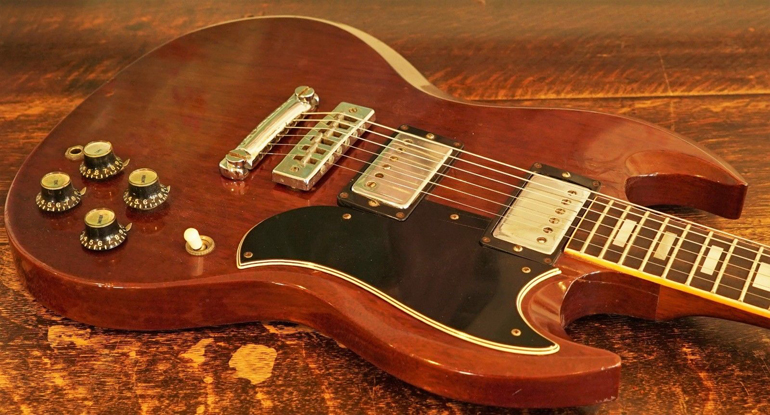
Vintage Gibson SGs, especially in collectable condition, can go for big money, early sixties examples especially. New SGs are start at around $1500 rising to $4500 for some historic reissues. Fine for guitar collectors, investors and rock stars. But for the majority of working musicians, this is a LOT of money. Add in the worries of keeping a Gibson safe from theft and damage in a bar/club gig and one has to question the sense in buying and using such a guitar. But this is where a 'players' grade guitar becomes the logical choice. A 'player' is exactly that - a guitar that functions every bit as well as new, but with the odd battle scar, replaced part, or repair that prevents it being a 'collector'. Plus you don't have to worry if you are not as careful with your guitars as you might like to be! The 1972 SG Standard in question has had a heel repair. Not a big deal if well repaired (as is the case here), with no measurable impact on sound or reliability. It seems otherwise all-original, and as such is actually a great example of a 'player'. Despite having the usual Gibson humbucker pickups, the early 70s SG Standards are a little less popular than older examples, in a large part due to the lack of a vibrato (with the long chrome cover) - but in turn are probably more stable players because of this.
This guitar is up for auction on ebay.com, with a low start price and no reserve. If not too many people spot this, it should stay cheap. Certainly one to follow if you want the sound of a vintage Gibson at a sensible price.
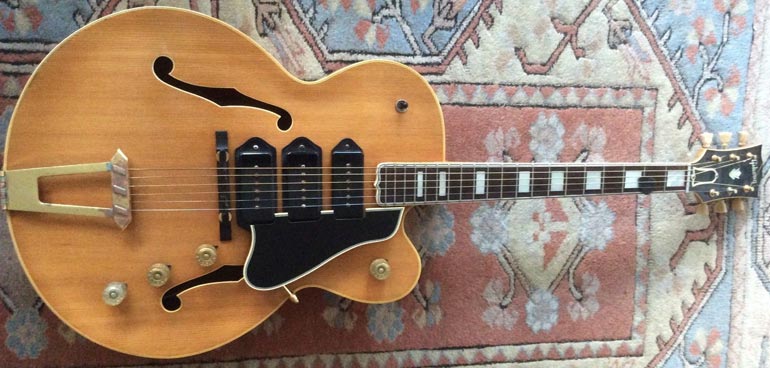
A mid fifties Gibson ES-5 is a very expensive guitar indeed. This one, from 1955 is one of just 11 Natural examples shipped that year (compared to 52 Sunburst). This one has had the pickups replaced but is otherwise original. At just under £4000, this still seems like a very fair price for such a guitar.
A very fine, seriously rare vintage guitar, offered at a lower price than a brand new Les Paul Custom. It's situated in Sheffield, UK. Check out more pics on ebay.co.uk
This is a very hard to find guitar catalog. It is the 1957 Rickenbacker guitar catalog, featuring solid body guitars, the 4000 bass, pedal steels, lap steels, and amplifiers. Guitar models include the 400, 450, 600, 650, 800, 900, 950 and 1000. The accompanying price list is dated July 1st 1960.
Book items look to be in reasonable condition, with some minor wear and discoloration. Nothing out of the ordinary for a 60 year old brochure. Check out these items on ebay.com
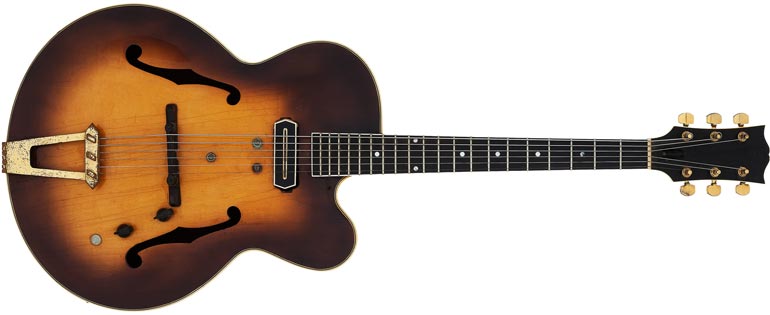
Barney Kessel's main guitar through his long career was this 1946/47 ES-350. It was an early single pickup version, but with the original P90 replaced by a '30s Charlie Christian pickup. The guitar, with all it's original modifications is available at Heritage Auctions in November 2018.
Read more about Kessel and his guitar here, or have a look at the auction lot at ha.com
edit: This guitar sold in November 2018 for $23,750.00
It used to be that ebay was full of sellers getting rid of a life time of vintage guitar paper: catalogs, price lists, dealer mailouts etc. Music stores closing down sold off boxes of the stuff, and there were some great, sometimes unique, finds, for anyone looking. Those days have sadly gone, and large stashes of collectibles come up far less often.
Prices always vary greatly with items like these on ebay. The notion of value is harder to apply to a letter, or a hang tag, for example, than to a guitar. And many items just don't get seen by prospective buyers. There is no one obvious category for guitar memorabilia, and great items often fall through the cracks.
The following two lots are from the same ebay seller, and consist of seven Gibson and five Martin price lists from the sixties and seventies. The price is currently very low - it may stay that way, or rise dramatically.
The Gibson price lists cover the years 1961, 1965, 1966, 2 copies of 1967, 1968 and 1970. Mid-late 60s price lists are not too hard to find, but the 1961 is rarer. All (except the cover of the 1970) seem in better than average conditions for their age.
The Martin price lists are not quite as clean, but certainly not terrible. They cover the years 1966, 1968, 1970, 1972 and 1975.
This is a really interesting instrument. It is a Bulgarian Orpheus bass, based upon the 1960s American-built Guild Jetstar. The Guild version was only made in small numbers, and was perhaps too odd looking to gain any mass appeal, though it clearly had it's fans. Sadly, this European copy doesn't have Guild's interesting headstock, but rest is pretty unmistakable. It is unlikely that the Orpheus sold in any particular volume. We know next to nothing about this guitar: scale length, timbers or reliability of components. How does it play? If you have any experience of this model, please leave a comment.
This great looking bass is for sale in Bulgaria. Maybe a collector or the basis of a totally unique project. Check it out on ebay.com
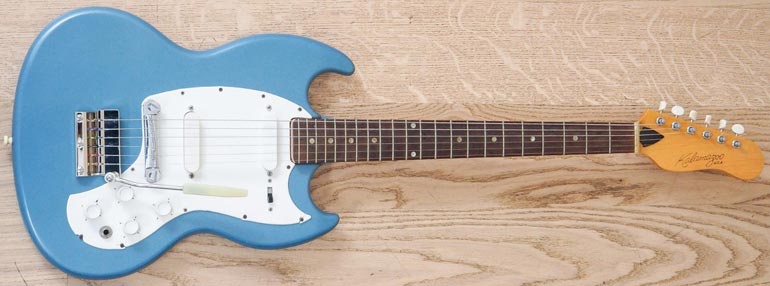
Kalamazoo was Gibson's 1960s budget brand, in the days before entry-level guitar production was outsourced to other countries. These guitars were built in Kalamazoo, USA; not at the famous Parsons Street plant where 1960s Gibson and Epiphone guitars were made, but at the old electronics plant across town. The bulk of Kalamazoo KG guitars were Fender Mustang style instruments, with a pressed board body, and bolt-on maple/rosewood neck. But the really desirable models were the later SG-styled examples. These were produced in smaller numbers, but as can be seen make a very attractive guitar. Single (KG1) and dual (KG2) pickup examples were made, in Red, White or Blue finishes, and fitted with a Maestro Vibrola (KG1A, KG2A) or stop tailpiece (KG1, KG2). Many of these guitars are parted out for the pickups or tailpiece. Finding complete examples is certainly becoming less common.
By far the most desirable incarnation of the Kalamazoo KG is the dual pickup, SG-style guitar with vibrola. And this one is in magnificent condition. Complete and all-original. The only damage appears to be some damaged scratchplate tips due to minor shrinkage. This is a superb example of a collectable mid-level guitar. It is listed a little on the high side for a Kalamazoo KG, but frankly, this is one of the best examples we've seen listed in a long time. Check it out on ebay.com
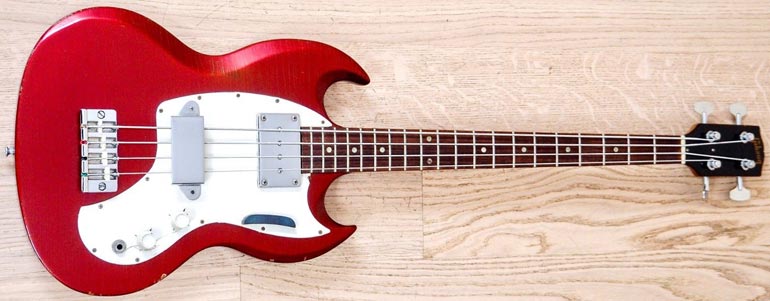
Gibson redesigned the Melody Maker guitar in the mid 1960s giving it the familiar SG body style and a Sparkling Burgundy or Pelham Blue finish, they also produced a number of Melody Maker basses. These were appointed in much the same way as the guitars: i.e. the same choice of finishes, and all electronics mounted onto the scratchplate, negating the need for a back body routes, and simplifying production. In terms of function, it was identical to the Gibson EB-0, with the same construction, dimension, timbers and components. Whilst the guitars were popular, the bass was only produced in small numbers, however shipping statistics are not available for this model. What is really nice about this bass is the condition of the finish. Sparkling Burgundy is especially susceptible to fading, often turning a deeper red or even copper color. This is caused primarily by excessive sunlight. The level of fading in this guitar is very small. Note the (very slight) color difference between the covered (below the scratchplate) and uncovered areas of this guitar. Surely an instrument kept in a case for the majority of it's life.
This beautiful guitar comes with a 1970s Gibson SG bass case. There is unfortunate damage to the scratchplate, but in all other ways is in really great condition. This guitar is not being given away, but the price is fair for age and exceptional finish condition. Check it out on ebay.com
The Hofner Club guitars are some of the most desirable of all Hofner models, and has been widely reissued. The single cutaway design is quite distinct. The Club 40 is the single pickup version - there were also Club 50 and Club 60 models. This guitar is, of course, associated with the early Beatles, John Lennon having famously bought a Club 40 from Frank Hessy's shop in Liverpool in 1959.
This one seems all-original and complete - missing scratchplates are commonplace on original examples. There is a suggestion that the neck may soon need resetting, but this is common with Hofner instruments, and not really a significant issue. The necks were attached with hide-based glue, which does not have the longevity of other glues, and does gradually slip. Like violins, these guitars were expected to have this joint reset periodically. An easy job for any luthier used to working with Hofner guitars.
Have a look at this rare Hofner on ebay.co.uk
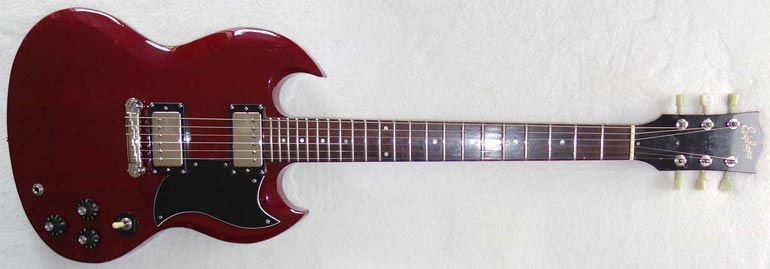
This is a very interesting guitar. In the early 1980s, Gibson were totally reorganising their brand identities: there was a lot to this move, but one result was the brief creation of Epiphone USA. The idea was scrapped as quickly as it came about, but a small range of guitars branded Epiphone USA were built at the Kalamazoo plant, in Michigan, USA. The first Kalamazoo-built Epiphones since 1969. There were two SG models, and the Les-Paul double-cutaway-style Spirit. These were nicely built set-neck solid body guitars, every bit as good as entry level Gibson instruments. The brief production period makes these some of the rarest Epiphone guitars out there. And being the output of Kalamazoo, they are totally respected guitars.
This one isn't in bad shape, but has had it's pickups changed. A very rare guitar that is a Gibson in everything but name. As such the buy it now price seems very fair indeed. Check it out on ebay.com
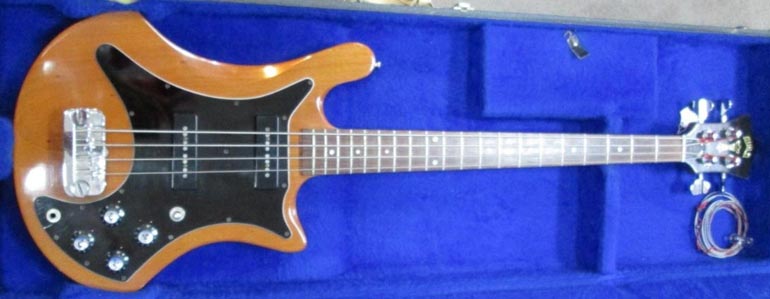
A nice Guild B302 bass in natural finish. Another very well regarded bass that often sells at prices below it's 'worth' as a playable instrument. This one seems complete and original, including with Guild hard case. These are, in our opinion, one of the instruments that will only go up in value. Certainly a bargain if it remains under $1000.
The Hagstrom Swede is one of those really highly respected instruments that doesn't come up too often in good condition at a reasonable price. They are great guitars, and although made in moderate numbers - around 7500, according to the Hagstrom shipping book - don't come up for sale too often. Owners don't tend to give them up easily. Furthermore, examples for sale often have headstock repairs, damage to the pickup surrounds or control knobs. All seems in good condition here, and as an auction with low start price, this could stay the right side of 'reasonable'.
This one also come with original hard case. Check it out on ebay.com
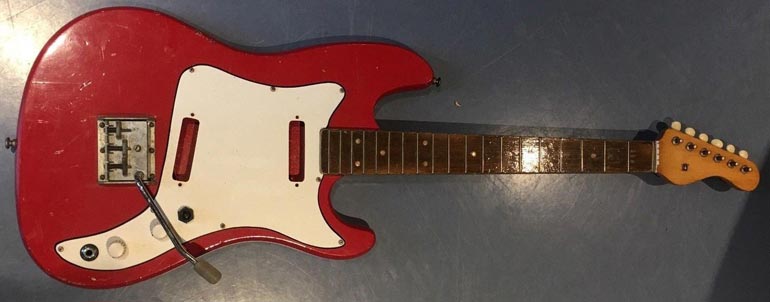
Here we have a British built JMI Vox Ace, made in the mid 1960s. The seller has no clue what they are selling, and makes several incorrect assumptions in the listing, that will surely deter bidders... The guitar is simply listed as a 'Vintage Electric guitar'. The guitar is not hugely valuable (superb condition examples don't sell much above £300) so this won't raise huge sums for the seller, however it is described. The body is a little rough, and the neck has no decals; and a varnished(?) fretboard. However all parts look original, and in workable condition. It's a shame there are no pickups. Probably one to part out - the 09-114-0 tuning keys were used on numerous Vox models, as were the knobs, electronic components and the De Luxe Tremolo. Compare with a 1965 Vox Ace
Price is low at the moment. See this project on ebay.co.uk
3356 3/4 size Melody Maker guitars were built at Gibson's Kalamazoo plant between 1959 and 1970 (compared to 24500 full scale guitars). Early sixties Gibson's, whatever the model, were well-constructed and well-finished. And often made from South American mahogany/rosewood. This one needs a new bridge, but seems otherwise complete and in great condition. The 3/4 scale guitar is shorter than the regular Melody Maker, but has the same body, just a shorter neck, that meets the guitar at the 12th fret (rather than 16th fret of the standard guitar).
An easy restoration project that will probably sell way below it's intrinsic value. See it on ebay.com
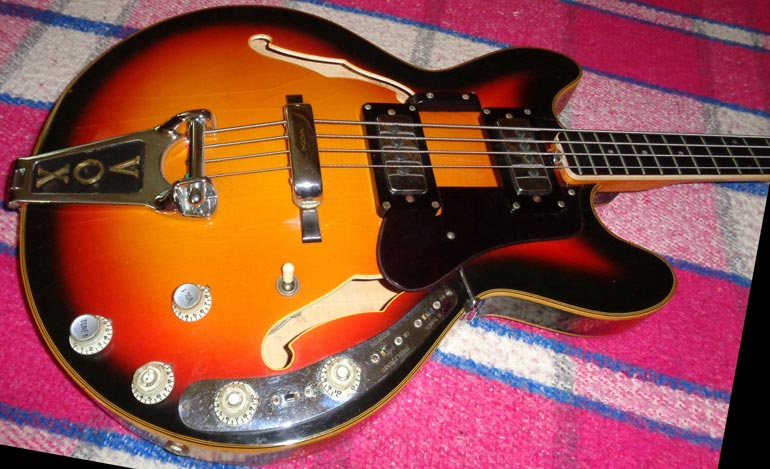
These 1960s Italian (EME) Vox guitars and basses are only going up in value recently, and seeing such a nice example below $1000 is becoming the exception rather than the rule. Finding guitars complete with all their parts (all knobs, bridge cover, scratchplate) and without serious finish cracking is certainly unusual. So this example represents a good deal for the Vox collector.
The Sidewinder bass is a lot of fun to play: it has built-in fuzz, G-tuner and treble/bass boost. Great for those 60s sounds - check out Larry Graham playing the Sidewinder with Sly and the Family Stone. The only downside (in my hands) is the slightly narrow neck width. Great for players with smaller hands, but a little thin for me.
Have a look at this bass on ebay.com
Anyone who follows this page will have noticed we flag up Gibson Melody Maker guitars quite often. They were produced in large enough numbers to be listed with some regularity, and although usually priced in the thousands, sometimes a bargain presents itself. And this is really great example. Firstly it's a 1950s Gibson. That fact alone is pretty special. It's one of the earlier Les Paul shaped single cutaway models, and on the surface seems in pretty nice condition. It has had a (fairly tidy) headstock repair, and replaced tuning keys (also maybe the tailpiece?). But the sunburst finish, both front and back, seems in great shape. This guitar clearly hasn't seen that much use.
The buy it now price of $1000 is good for a '59 Gibson; the start price of $650 is crazy low. Whatever parts are replaced, old mahogany and rosewood are not being made into guitars these days. Surprisingly there are no bids yet. This is a great old guitar at an affordable price. Have a look at more pictures on ebay.com
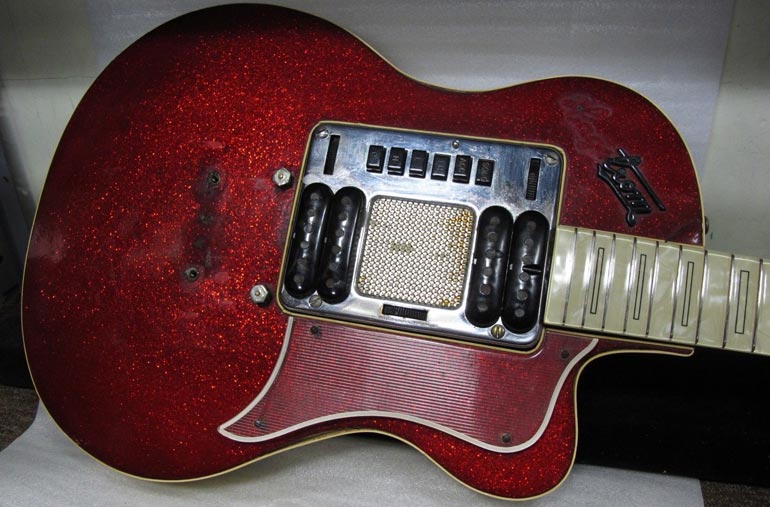
This won't last long. Early 1960s Hagstrom guitars are in a lot of demand. This one is in fairly good condition, though there are a few parts missing: bridge, tailpiece and some of the original Hagstrom logo. The serial number is 499070 - batch 499 being of 300 Hagstrom De Luxe guitars produced between 1961 and 1962
This one is in San Francisco, California. Check it out on ebay.com
The Martin 00-17 acoustic is a really nice guitar. Unlike the better known spruce-topped models, this is all-mahogany: top, back and sides. The fretboard is Brazilian rosewood. Very nice woods, that don't get made into guitars these days. I bet it sounds superb!
This one seems to be in good vintage condition (though description is very limited), with a (currently) good price - but naturally a lot of interest. The lack of description in this listing could deter bidders.. it might stay reasonably priced. It's in London, UK - check it out on ebay.co.uk
This is interesting. I've seen this before on some Gibson bass guitars circa 1976 - certainly other Rippers (and perhaps an RD?) The original truss rod is just a shade too long, and protrudes, just a little, from it's cavity. Gibson dealt with this by raising the cover by use of the spacer shown. The actual truss rod cover is the same as on any other Ripper.
There can't have been too many Rippers with this correction, probably tens rather than hundreds, so it's a pretty rare piece. The seller is parting out a Gibson Ripper - check out this and other parts on ebay.com.
Gibson's low impedance guitars of the early seventies were superb instruments, though the controls did need some explanation. The guitars in question are the Les Paul Recording and Les Paul Triumph models. So in 1971, Gibson published a fold out cardboard brochure explaining some of the guitars features and it's operation. It came with a flexi disc with Gibson's Bruce Bolen demonstrating the guitar, and narrated by Les Paul himself. With the guitar's sauces, the brochure was reprinted in 1973 - identical in content though printed on slightly larger board. This example is exceptional condition, and somewhat unusually, still has the original flexi-disc. You can have a listen top a recording of the disc here.
This is just great case candy, and in considerably better condition than most examples on the market - check it out on ebay.com
The long scale version of Gibson's EB0 bass was first shipped in very early 1970. The seller lists this as a 1968 EB0, but it is clearly a '70s bass (MADE in USA says 70s; serial number suggests early '71; lack of mute concurs), and 34" scale like a Fender Precision or Jazz (the bridge is further forward on short scale models). Overall condition isn't great, but neither terrible - it obviously has had a life of use, but the dreaded headstock break (so common on these slotted headstock basses) is yet to happen (don't drop it!), and the finish, though dulled and scratched is still the original translucent cherry. There is a missing truss rod cover (that would have held the scripted EB-0L model designation) and the glued-on pearl Gibson logo is also damaged.
It has also had several hardware changes. The pickup has been replaced by a Dimarzio model one - designed specifically for brightening up the fat EB tone. Thankfully, the accompanying coil tap switch has not been fitted - so no extra mini toggle by the controls. The original control knobs would have been black witch hats. The bridge posts and saddle screws look to be non original, and the bridge cover is missing. So by no means an immaculate or completely original bass. But nothing done to this bass is irreversible. One could restore this fairly easily, with most parts popping up on ebay every month or two (also check out the Gibson bass parts on vintageguitarparts.co).
This bass is priced to sell. It has a .99c start price (though with a reserve) and a buy it now of $600. The EB-0L is a rarer, more useable version of the EB0, and if you actually prefer a less wooly tone than a typical Gibson EB, the Dimarzio is probably the best choice. Frankly, this is about as cheap as a Gibson bass gets, and if you don't like it, you will almost certainly be able to flip it and get your money back in no time at all. Have a closer look on ebay.com
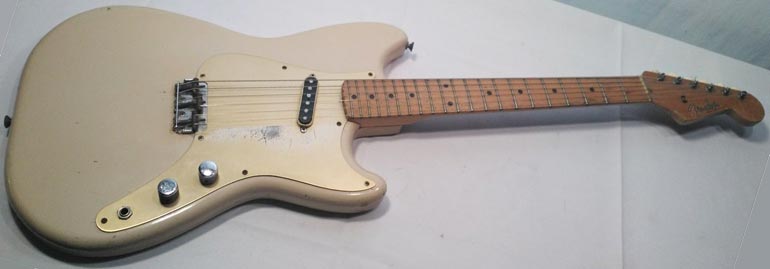
1950s Fenders go for big money. BIG money. They are highly collectable, and generally great playing instruments, though the Musicmaster, tends not to attract the same attention as a Stratocaster, for example. Although every bit as well made as any other 50s Fender, with a solitary pickup, and no tremolo they are perhaps under-equipped - at least compared to a strat or tele. Furthermore, this example is a 3/4 size instrument (i.e. with a 22 1/2" scale). Whilst it is old, and relatively rare, it is of limited use to a typical player. With it's non-original pickup, and missing bridge cover, it is also less appealing to a collector.
But it isn't in bad condition at all. Like all early Musicmasters, it was finished in Desert Sand, and fitted with a gold anodized aluminium scratchplate. Great condition examples sell generally get listed around $1500 - $2000. Although it is missing the fore mentioned parts, it looks to be in pretty sound condition otherwise. With a start price of $400 and no reserve this could very likely represent a good deal for the lucky winner. Someone out there will have an original pickup, and maybe a bridge cover. This one just begs to be re-completed.
Check out this guitar on ebay.com
Replacement parts for some guitars are harder to source than others, particularly those produced by small manufacturers, or from brands that never offered their parts as aftermarket upgrades. Pickups can be easier to source due to the fact that players often 'upgrade' their guitars (even though they may simply need a set up - but that's another story). This listing is for a bunch of parts for a 1975 Hayman 3030: pickups, scratchplate, wiring loom, bridge, neck plate, serial number plate and strap buttons. There are also a few bits (notably the tailpiece and a rosewood bridge base) that do not belong. These are hard to find parts, that could easily have been listed at a significantly higher start price - but with an opening bid of just £1, the seller is letting the market decide their value. Someone out there will desperately need these parts; let's hope they spot the listing. Nothing worse than seeing the final piece of your jigsaw go for a pittance the week you neglected to look!
These parts are in Blackpool, UK, and can be seen on ebay.co.uk
The Gibson ES-120T (like it's Epiphone companion model, the Granada) was the entry level model in Gibson's thinline electric acoustic range. Like the ES-330TD it was a thin, completely hollow body guitar, (i.e. no feedback reducing maple center block) with a body depth of 1 3/4". Well built, out of nice woods, double bound (front and back) with a mahogany neck and rosewood fretboard. They are nicely made instruments, but with limited fretboard access (no cutaways), and just one PU-380 Melody Maker pickup in the neck position.
This one has been poorly listed - maybe deliberately, maybe not. There are insufficient images, and even less description. There is no mention or picture of the neck (is it cracked and in need of work? previously repaired? totally fine? Who knows?). The tuning keys have been replaced (twice, by the looks of it). But even with a little work required, at it's current price, this guitar is a bargain.
This is unlikely to go too high - just not enough information to instill confidence in most bidders. Probably worth contacting the seller for further details, but a potential great deal for the right buyer, especially if the neck is unbroken. See this guitar on ebay.com
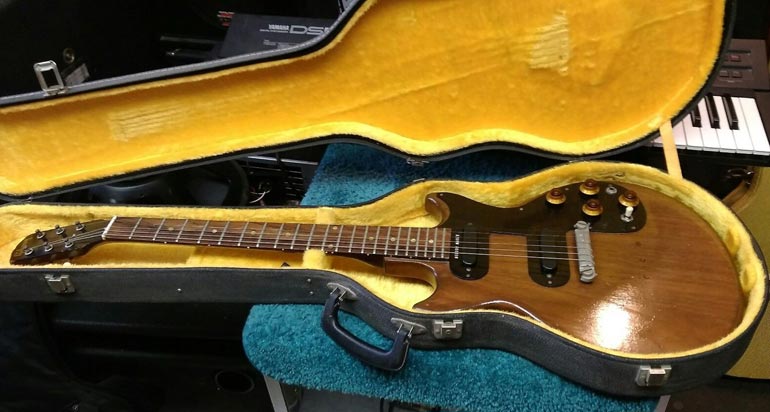
Some guitars are desirable due to their rarity.. others because of their reputation as players. The Gibson Melody Maker was neither produced in sufficiently large numbers to be considered especially rare, nor equipped with sufficiently notable hardware to out-compete more expensive guitars. But original Gibson Melody Makers are desirable, both by collectors and players alike. But in my book, the best Melody Maker is one that has had a few upgrades - nothing irreversible, mind, just a few direct replacement parts to give a stronger output and a little more tuning stability. Early and mid-sixties Gibson guitars were exceptionally well made, out of really nice woods. This two pickup guitar with original case, despite the refin, has got to be worth the opening bid of $750.
You can find this Melody Maker on ebay.com
The ASB-1 Devil Bass was only made for a brief time, with perhaps only 75 instruments produced. Like the AEB-1, it has an unusual cut-through body and scrolled headstock like an upright, and was available with either a fretted or fretless fingerboard. Early Ampeg basses are highly desirable, and pretty rare to boot. Examples listed on Reverb tend to be priced $4000 and up, so it's good to see this one listed at 0.99c! Obviously there's a reserve, but for once we shall see what the market deems this rare bass to be worth.
This bass has some finish wear, but seems to be complete and original. Rare, collectable, and freakishly interesting in equal measure. Definitely a bass to watch!
Check out more pictures on ebay.com
EDIT: Bidding got up to $2000, but the reserve was not met. Currently re-listed and accepting offers.
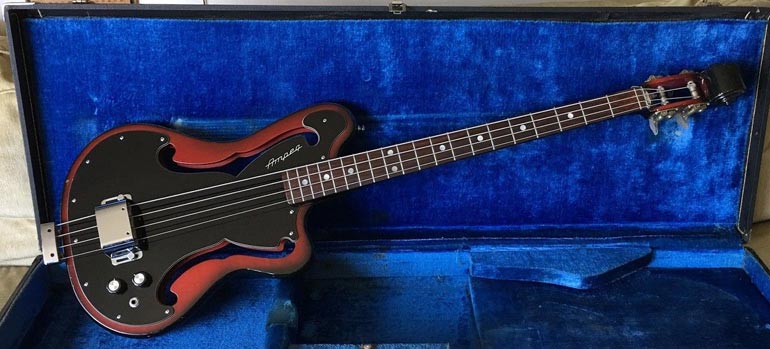
Now this is a great bass - and one that doesn't come up too often. Ampeg, were obviously better known for their amplifiers, but were also producing fretted and fretless AEB / AUB basses from 1966 until the end of the decade. Along with the ASB-1 Devil basses, these had a scroll headstock, like an upright bass, and like the Ampeg Baby bass electric upright that had preceded them. These horizontal electric basses are often referred to as Ampeg scroll basses. Pretty distinctive looking, and great sounding. I always associate these basses with the Hendrix / Curtis Knight sessions of 1967 (check out Hush Now, if you don't know it ), and Funkadelic circa 1969/70. This one seems to be in pretty good condition. Nice bass.
See more of this bass on ebay.com
EDIT: This bass sold for $2531.88
...or sign up to our mailing list to have picks email directly to you